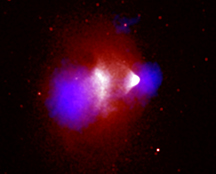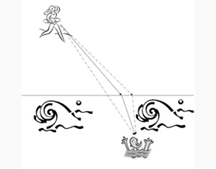


- MAKE YOUR OWN EXHIBIT
- WATCH A VIDEO
- READ A BLOG
- TACTILE & BRAILLE HTE
- AMERICAN SPACES
- PIN SOME IMAGES
- SHARE WITH A FRIEND

Topics: bending of light.
More about Bent Light.

The bending of light by a lens or by the atmosphere is an example of refraction, and is due to the change of the speed of light as it moves from one medium to another, such as from air to glass, or through air which is gradually changing in density. This behavior is an
example of "the principle of least action," or in the special case of light, "the principle of least time," which means that the path taken by a ray of light is the path that can be traversed in the least time.
More Info.
Imagine you are a life guard on a beach, and see a swimmer drowning off shore. Since you want to get to the swimmer as quickly as possible, and you can run faster on sand than you can swim, you don't take a straight line path, but a bent one that gets you there in the least possible time. Likewise, light travelling from one medium to another bends, and the travel time from one point to another is minimized.
For more information, see:
http://brianclegg.blogspot.com/2012/07/the-baywatch-principle.html
http://lifshitz.ucdavis.edu/~dmartin/phy7/7C/Refraction/air-water2.png
The same general principle can be used to show that light follows the curvature of space, so light rays bend when passing by a massive object. By using the "gravitational telescope" provided by gravitational lensing, astronomers can study many phenomena such as the distribution of dark matter in galaxy clusters, and the nature of accretion disks around black holes.
For simple descriptions of gravitational lensing see:
http://chandra.harvard.edu/xray_astro/dark_matter/index3.html
http://imagine.gsfc.nasa.gov/docs/features/news/grav_lens.html
For a somewhat more detailed discussion, with links to technical articles, see:
https://en.wikipedia.org/wiki/Gravitational_lens
A video of a lecture on gravitational lensing:
http://www.pdxjustice.org/node/55

Image: Robert Horton

Image: X-ray: NASA/CXC/CfA/M.Markevitch et al.; Lensing Map: NASA/STScI; ESO WFI; Magellan/U.Arizona/D.Clowe et al.
Fun Facts on Bent Light:
- Refraction of light can produce mirages, such as the appearance of water on hot highways, or in the desert.
http://aty.sdsu.edu/mirages/mirintro.html - Scientists and engineers have used to the bending of light by refraction to make a prototype of a cloak of invisibility.
http://blogs.scientificamerican.com/guest-blog/2011/01/11/invisibility-after-several-years-of-research-its-just-gotten-weirder/ - Stars twinkle because starlight is refracted as it passes through the atmosphere because the light passes through rapidly moving cells of air with different density, temperature, etc. These cells bend light by different amounts, and make the apparent position of the star move around. This movement is seen as twinkling.
http://imagine.gsfc.nasa.gov/docs/ask_astro/answers/981217a.html - A study of gravitational lensing due to the Bullet Cluster has helped to produce the best evidence yet for dark matter.
http://chandra.harvard.edu/photo/2006/1e0657/more.html - The ultimate light bender is a black hole, which can bend light rays into a closed loop so they never escape the black hole.
http://casa.colorado.edu/~ajsh/home.html
http://naasbeginners.co.uk/AbsoluteBeginners/Black_Hole_files/Blackhole_9.jpg
Back to Bent Light page

"Here, There, & Everywhere" (HTE) is supported by the National Aeronautics and Space Administration under grant NNX11AH28G issued through the Science Mission Directorate.
HTE was developed by the Chandra X-ray Center, at the Smithsonian Astrophysical Observatory, in Cambridge, MA.
Email: cxcpub@cfa.harvard.edu | Phone: 617.496.7941
Follow us: #HTEScience on Twitter

